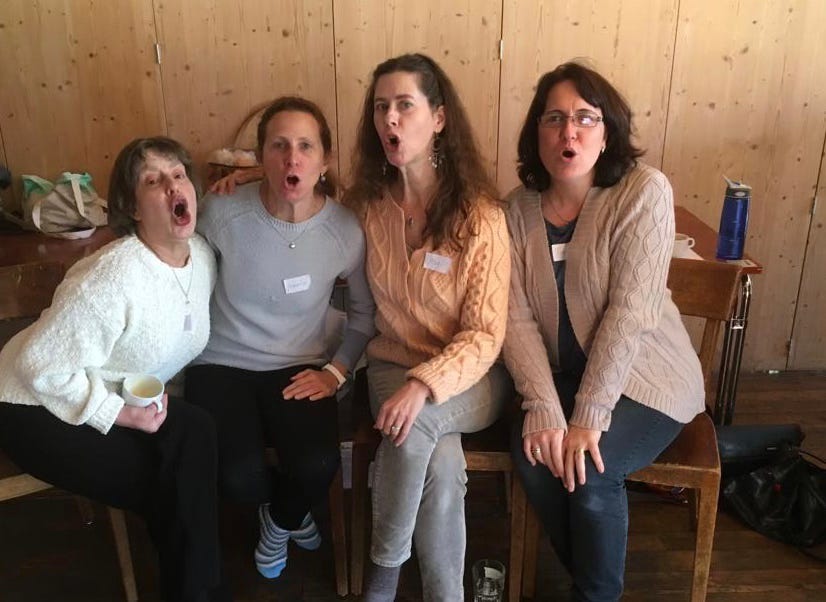Yes, yodeling. Told you it was different!
I am a classically-trained mezzo soprano who also lives in Switzerland, so it was inevitable that one day there would be a Happy Wanderer about yodeling. Readers, that day has arrived!
What is your first association when you hear the word yodeling? I would bet that most of us, if we even have any concept of yodeling at all, think of “The Lonely Goatherd” from The Sound of Music.

We tend to view yodeling as old-timey and kind of dorky. Or at least I did. And then I attended an afternoon yodeling workshop with a group called Stimmklang (vocal sound), which opened my ears to a whole ’nother world.
So What Is Yodeling Anyway?
Yodeling is not what you think it is, or not quite. Yes, yodeling can be heard in folksongs from the Alps and other mountain regions, but it’s actually a singing technique in which singers shift rapidly back and forth between vocal registers. Yodelers emphasize the different qualities and sounds of the two registers, as well as the break between them. What the heck does all that mean? Read on!
We have two vocal registers, the chest voice and the head voice. Most of us use only our chest voice in everyday life. This register resonates in the chest (hence the name) and is lower in pitch and more forceful than the head voice. We speak in our chest voice.1 Head voice, by contrast, is lighter and higher.2 Without training, the head voice is soft and breathy, but with training, it can be extremely loud and powerful. Opera singers sing in head voice almost exclusively, and their unamplified voices carry over full orchestras and fill enormous halls. The head voice offers a much larger vocal range too. For example, the range of my chest voice is just over an octave, while my head voice has a two-and-a-half octave range. The head voice is also easier on the vocal chords than the chest voice is. Opera singers can safely perform several nights a week, whereas pop singers who use their chest voices too much can develop nodes (almost like calluses) on their vocal chords.
To hear the difference between head and chest voice, listen to the beautiful song below. For most of the song, Harry Styles sings in his chest voice, but the refrain, “We never learn we’ve been here before,” is in his lovely, pure head voice.3
As singers shift from chest to head voice, they encounter a break—a kind of crack or click. You can experience this phenomenon yourself. Try singing a scale that starts at the low part of your range (or, if you’re like me and now have the entire soundtrack of The Sound of Music stuck in your head, you can sing “Do-Re-Mi”). Sing out those bottom notes loud and proud: That is your chest voice. As you move up the scale, you will discover that you aren’t able to maintain that powerful sound, and at some point your voice will flip naturally into a lighter tone. Your voice might even crack, similar to how teenage boys’ voices crack when they change. This is the break in the voice, and all of us have it.
We aren’t accustomed to hearing the vocal break because—apart from the “cry break” in some country songs—it doesn’t appear in most of the music we listen to. Pop singers usually sing in just the chest voice (or, in Taylor Swift’s case, in just the head voice). And classical singers work—sometimes for years [sheepishly raises hand]—to smooth over the break, to blend the chest and head voices seamlessly, and to create a unified sound across our entire vocal range. In fact, in classical singing the break is called the passagio, or passage, implying that it is not a rupture to be avoided, but rather a transition to be moved through. One reason yodeling sounds weird to us, then, is not because it is an inferior way of singing, but rather because the vocal break and the contrast between chest and head voice in yodeling is unfamiliar to us.
Yodelers of the World, Unite!
That being said, some beloved pop singers do in fact sing in a way that could be called yodeling. Alanis Morrissette is probably the most obvious example, but other pop yodelers include Dolores O’Riordan from the Cranberries and Adele. Men yodel too, for example Chris Isaak in “Wicked Game” and Dan Baird of the Georgia Satellites in “Keep Your Hands to Yourself.” My favorite example of a popular song that owes its power and unique sound to yodeling is “What’s Up,” by 4 Non Blondes. In the video below, listen at the one-minute mark (“And I cry sometimes when I’m lying in bed”) to hear Linda Parry shifting from head to chest voice and leaving the break in instead of concealing it:
Yodeling is also found in folk music from around the world. Our teacher told us that songs from herding and cowboy cultures often incorporate the yodeling technique, because yodeling is a vocally healthy way to produce enough sound to carry across wide expanses, enabling herders to communicate with each other. Many American cowboy songs are yodels (if you sing “Home on the Range” to yourself, you’ll see what I mean). You can check out the following links to hear wonderful yodeling from Norway and, of course, Switzerland.
The Health and Beauty of the Natural Voice
Yodeling is a healthy way to sing, even though most yodelers don’t learn proper technique in lessons or workshops like the one I took.4 We know yodeling is safe for the voice because yodelers don’t seem to suffer from the scourge of nodes, perhaps because they learn by observing, listening to, and singing with each other. Our workshop included the kind of posture and breathing exercises that all my voice teachers and choir directors teach. Our leader even taught us to sing with a “fish mouth,” which I had previously learned about from my former voice teacher Eva, a Czech soprano (“Fish mouth! Fish mouth!” I can hear her reminding me in her pretty accent).

And even opera aficionados will be moved by a pure and healthy, albeit untrained, voice. A while back, I ran across a passage that perfectly captures the raw power of a natural voice. In War and Peace,5 Tolstoy tells of the first time Natasha sings in public as a young woman and sends her audience into raptures:
Natasha took the first note, her throat expanded, her chest straightened, her eyes acquired a serious expression. She did not think of anyone or anything at that moment, and from her lips composed into a smile sounds poured forth, sounds that anyone can produce for the same lengths of time, at the same intervals, but which leave one cold a thousand times, then for the thousand and first time make one tremble and weep.
What is this mystery? How does Natasha do it? It’s not training or technique; it’s a special quality that is intrinsic to her unique, lovely voice:
her singing was not good yet, as all the critical connoisseurs said who had heard her sing. “Her voice has no polish, it’s beautiful, but it needs polish,” they all said. But they usually said it long after her voice had fallen silent. While this voice with its wrong breathing and strained transitions was singing, even the critical connoisseurs said nothing and merely enjoyed this unpolished voice, merely wanted to hear it again.
Life Lessons from the Yodeling Workshop
Turns out that yodeling is a symbol for life; in yodeling as in life,
There are many ways we can express ourselves in a healthy way. We may not have formal training, but we can still enjoy lifting up our voices together.
Difference does not imply hierarchy. The head voice is not better than the chest voice; each voice, talent, and interest has its own valuable role.
A break or transition doesn’t have to be an ugly rupture, or something to be hidden away. It can be a vital part of a beautiful whole.
We will be happier if we abandon our desire to seem cool, stop worrying about looking silly, and let ourselves enjoy trying something new.
How about you, readers? Have you ever tried something completely different? What did you learn? Please share your thoughts in the comments!
The Tidbit
On occasion even opera singers will play with their head and chest voices, highlighting their different qualities, as the video below demonstrates. The music begins at 2:20, and you can hear Leontyne Price’s extraordinary control of her head and chest voices at 3:21. I highly recommend watching the whole video, because at about 7:45, everyone starts rocking out to “This Little Light of Mine,” and it is impossible not to smile, and maybe clap and sing along.
Most of us do, anyway. Some opera singers, in order to protect their voices, speak in their head voices.
Head voice is different from falsetto. While a trained head voice is full and rich, falsetto has a reedy, thin, piercing quality. Falsetto singing was huge in the fifties, sixties, and seventies—think of Frankie Valli, the Beach Boys, the Bee Gees, and the Eagles, for example. My theory is that the falsetto trend ended when Eddie Vedder and his gorgeous baritone came along, and listeners thought, “Whoa! More of this, please!” I mean:
Incidentally, this video was not filmed with a green screen. Styles was really being towed by a helicopter through the air and above the clouds. Is there nothing he can’t do?!
Last year I sang in a concert with a Swiss women’s chorus, and several of the singers were the daughters of yodelers who had learned to yodel literally at their parents’ feet. They yodeled the solo line of one song, while the rest of us sang a choral accompaniment. It was a wonderful experience!
These quotes are from the translation by Richard Pevear and Larissa Volokhonsky (Knopf, 2007), p. 539.






Ranger Doug, Idol of American Youth, and "How the Yodel Was Born": https://www.youtube.com/watch?v=-2N7NZVkKBg
I learned a lot from this post! When Emily and I sang in a world music choir, we learned Eastern European and Balkan music that emphasized frequent voice breaks. The female vocal style in some of those folk traditions is thinner and higher in the throat, which makes it easier to force frequent breaks. I sang in that style a lot and really enjoyed the challenge, but I wouldn’t have been able to articulate what I was doing before :)
I love Laboratorium Pieśni’s yodeling style: https://m.youtube.com/watch?v=wkxKfDmKzrk